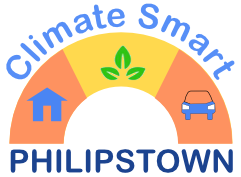LAND USE

Changing how we manage our lawns, recreation fields, parks and golf courses could help developed open spaces in Philipstown fight climate change by storing 25% more carbon
FACT
The greenhouse gas emissions from mowing, along with fertilizer and pesticide production, watering and leaf blowing were found by University of California to be four times greater than the amount of carbon stored by grass, in other words, a conventional lawn contributes to climate change by producing more carbon dioxide that it absorbs.

-
Mowing Less
-
Chemical Free Lawns
-
Electric Landscape Equipment
-
Plant Diversity
Controlling Your Carbon Emissions
1. MOWING LESS
The best thing for your lawn and the environment actually means less work for you.
-
Studies have shown that lawns mowed every two or three weeks resulted in better growth or the grass root system making the lawn more resilient to drought and other stressors.
-
Seed the lawn with clover to return the nitrogen to the soils and feed the bees.
-
Let your lawn go natural by not mowing a section. Your may be surprised to find a number of wild flowers. Note: If you find an invasive plant, pull it before it goes to seed.
2. CHEMICAL FREE LAWNS
Eliminate synthetic fertilizers, pesticides and herbicides that have a high carbon cost and harm wildlife and water.
Synthetic fertilizers, pesticides and herbicides have a high carbon cost, and they harm wildlife and water. They can also directly impact soil microbes. Microbes are the movers and shakers of carbon sequestration. They transform organic matter from plants and animals into soil organic carbon, a process that builds soil fertility and draws carbon from the atmosphere and locks it away! Having more carbon in the soils is transformative. It means better water infiltration, higher nutrient and water retention.
-
Lawn chemicals can be a risk to beneficial insects, birds, and other forms of wildlife
-
Through infiltration and run-off, these chemicals are frequently sources of pollution in well water, streams and rivers
-
Instead of using fertilizer, apply a light layer of compost, leave the grass clippings on the lawn to return nitrogen, and in the fall, leave the leaves and mulch mow them in place. This will return nutrients to the soil. This will help feed the soil microbes.
-
Remember healthy soil with lots of microbes = carbon sequestration!
3. ELECTRIC LANDSCAPE EQUIPMENT
Lawn mowers enit ten times more hydrocarbons than a typical car for every hour of operation.
Lawnmowers emit ten times more hydrocarbons than a typical car for every hour of operation.That means in one hour, a commercial lawn mower spews as much smog forming pollution as driving a 2017 camry for 300 miles and backpack leaf blowers produce as much carbon in one hour as a car driving 8 hrs.
Switch out gas powered mowers, blowers, chainsaws, hedge trimmers, and other yard equipment for electric powered. Electric equipment is cheaper to operate because it runs on a battery charge, not gasoline, and is easier to maintain because it does not require maintenance like tune-ups and oil or spark plug replacements. While the noise of many gas-powered mowers or blowers can cause hearing damage to the operator, electric equipment is so quiet you can carry on a conversation while using it.
Check out these great resources to learn more about electric lawn equipment.
4. PLANT DIVERSITY
Increase your plant diversity by planting a pollinator garden.
Diverse native plantings can help increase carbon stored in the soil while also feeding and providing habitat for the pollinators, like birds, butterflies, and bees.
It’s time to take action! For more information and advice on how to make your yard or open space more climate-positive, contact Climate Smart Philipstown’s Land Use Committee: climatesmartphilipstown.org csphilipstown@gmail.com



